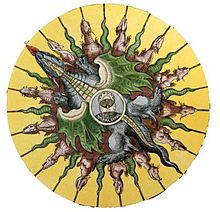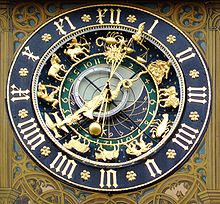Dragon pointer

The dragon pointer shows the position of the lunar nodes in the ecliptic or in the zodiac on an astronomical clock . When a solar or lunar eclipse occurs, the dragon hand will coincide with the sun and moon hands.
description
The nodal line - the line connecting the two nodes - rotates once every 360 ° in the ecliptic every 18.61 years . Their direction of rotation is opposite to that of the sun and moon.
A solar or lunar eclipse only takes place when the sun and moon meet at one of the two nodes. According to an old Chinese belief, the sun or the moon is devoured by a dragon (and then spat out again) when it is dark. This goes back to calling the pointer for the knot line the dragon pointer.
Presentation and display
The pointer is usually shown as an elongated dragon:
- the dragon's head shows the current position of the ascending knot in the zodiac
- the dragon's tail shows the current position of the descending knot in the zodiac
If the kite is shown from the side, further information can be read:
- If the moon is above the dragon's back, it is also above the ecliptic in the sky.
- If the moon is under the kite's belly, it is also under the ecliptic in the sky.
Solar eclipse
An earthly solar eclipse is an astronomical event that occurs when the sun is completely or partially obscured by the moon. This event can only occur when the moon is in a line between the earth and the sun. It must therefore also lie in the ecliptic plane, i.e. be in a lunar node (dragon point).
On the astronomical clock, the sun hand (sun), the moon hand (moon) and the head or tail of the dragon hand (knot) are superimposed on each other.
Since solar eclipses can only be seen in small areas on earth, it is not certain that a displayed solar eclipse will actually be visible at the location.
lunar eclipse
A lunar eclipse is an astronomical event that occurs when the moon wanders through the shadowy space of the earth. This event can only occur when the earth is in a line between the moon and the sun. The moon must therefore also be in the ecliptic plane, i.e. in a lunar node (dragon point).
On the astronomical clock, the sun hand is at one end and the moon hand is at the other end of the dragon hand.
A lunar eclipse can only be seen from the hemisphere facing away from the sun.
literature
- Erik Damm: Basics of Astronomical Clocks. Books on Demand, Norderstedt 2009, ISBN 978-3-8391-0361-6
- Hans Scheurenbrand, Michael Schwarz, Hermann-Michael Hahn: Festo Harmonices Mundi. Astrolabe, calendar clock and carillon. Construction, function, precision. Franckh-Kosmos, Stuttgart 2005, ISBN 3-440-10329-3 .
Web links
- The astronomical clock at Ulm City Hall Telebus
- Tübingen's astronomical clock has the oldest dragon pointer University town of Tübingen (archive)
Individual evidence
- ↑ Joachim Herrmann : dtv atlas for astronomy (= dtv 30069). 2nd Edition. Deutscher Taschenbuch-Verlag, Munich 1974, ISBN 3-423-03006-2 , p. 51.
- ↑ The Astronomical Clock - Task and Function, Trenduhren24.com .
- ↑ Dragon pointer, Telebus [1]

